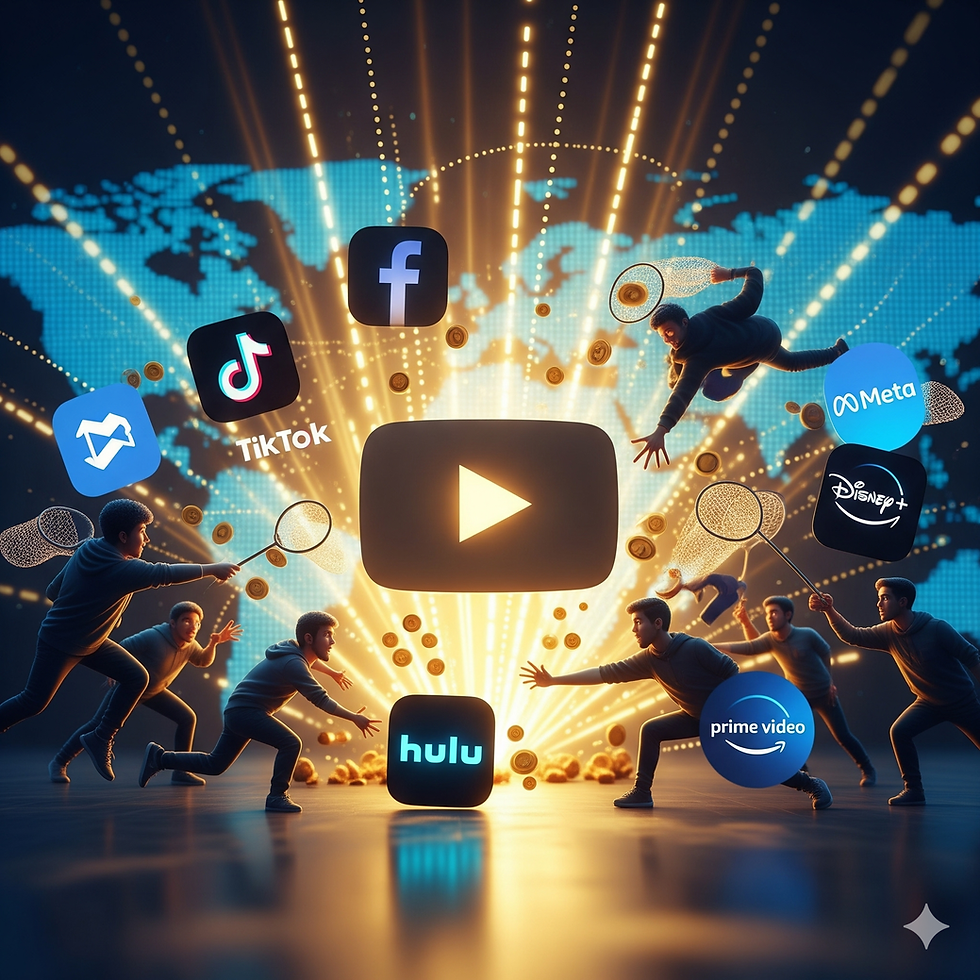The Global Race for Video Ad Dollars: YouTube Still Reigns, Rivals Scramble for Monetization Share
- Nitin L Maniar

- Sep 8
- 4 min read

By Nitin Lalitkumar Maniar | Senior Technology Correspondent
In less than two decades, video has become the internet’s dominant language. From YouTube’s garage origins in 2005 to TikTok’s billion-user surge, platforms are not only vying for our eyeballs but also for creators’ loyalty. At the center of this battle lies a simple question: who pays the most for a million views?
A sweeping analysis of global video platforms up to August 2025 shows stark differences in monetization models, ad revenue sharing, and creator payouts across regions. The results confirm what many creators already know: while rivals innovate on format and engagement, YouTube remains the undisputed king of ad revenue.
YouTube: The Billion-Dollar Creator Economy
With more than 2.7 billion monthly active users, YouTube has turned video into a profession. Its Partner Program (YPP), launched in 2007, has become the industry benchmark: creators keep 55% of advertising revenue, while Google takes the remaining 45%.
That structure has proven lucrative. Alphabet disclosed that YouTube has paid creators over $70 billion in the past three years—an unprecedented redistribution of ad dollars .
For creators, the math is clear. Advertiser CPMs (cost per thousand impressions) average $13–15 in the U.S. and Europe . After YouTube’s cut, creators typically pocket an RPM (revenue per thousand views) of $5–7, though finance, tech, and luxury content can push these numbers much higher. A million monetized views can generate $1,200 to $6,000, dwarfing payouts on short-video competitors.
TikTok: Virality Meets Meager Payouts
TikTok, with 1.6 billion monthly users worldwide , redefined short video and rewrote attention spans. Yet, its payout model lags far behind. For years, creators relied on the TikTok Creator Fund, a capped pool that paid a paltry $0.02–$0.04 per 1,000 views —meaning even viral sensations earned tens, not thousands, of dollars per million views.
In 2022, TikTok rolled out TikTok Pulse, finally offering a 50/50 ad revenue split . But the catch is eligibility: only the top ~4% of videos qualify, and creators need at least 100,000 followers. Even today, only select U.S. and Western creators are benefiting as the program expands globally.
The disparity is stark: TikTok advertiser CPMs hover around $3–$6, yet creators outside Pulse see almost none of it. For now, TikTok rewards fame with reach, not revenue.
Twitch: Ads Play Second Fiddle to Subscriptions
Amazon-owned Twitch built its empire on live streaming. With 240 million monthly users and nearly 35 million tuning in daily , Twitch dominates gaming culture. But monetization is another story.
Twitch’s ad program starts creators at a 30% revenue share, rising to 55% if they agree to run three minutes of ads per hour . Advertisers typically pay $3–$6 CPM, translating to $1.5–$3 per thousand ad views for creators. In contrast, YouTube often delivers double or triple that.
For most streamers, income comes from subscriptions (split 50/50) and viewer “Bits” (tips), not ads. A popular streamer can make a living, but ad revenue alone is rarely enough.
Meta’s Double Play: Facebook and Instagram
Meta’s approach blends legacy scale with experimental monetization. Facebook Watch shares 55% of in-stream ad revenue with creators , mirroring YouTube’s model. Advertisers spend heavily—CPMs in the U.S. run $7–$12—so creators can net $4–8 RPM. In 2024, Meta reported paying out over $2 billion to creators in a single year .
Instagram has been less stable. IGTV ads launched in 2020 with a 55% split but were discontinued by 2022 . Reels monetization today relies on limited bonus pools, meaning creators can’t count on steady ad-share income. For Instagram’s 2+ billion users, visibility is huge—but revenue reliability is not.
Vimeo: Tools, Not Ad Dollars
Unlike its rivals, Vimeo never pursued mass-market ad revenue. Instead, it caters to professionals with OTT services that let creators run their own subscription or ad-supported channels . Vimeo takes a platform fee, not a percentage of ad sales, making it a niche solution for businesses rather than influencers.
Regional Divide: The RPM Gap
Ad revenue is not uniform across geographies.
United States & Europe: Premium CPMs ($10–15+) and strong advertiser demand make these regions the most lucrative.
India & Southeast Asia: Huge audiences (YouTube India has hundreds of millions of users), but CPMs often fall below $2–3. TikTok, banned in India since 2020, dominates in Indonesia and the Philippines.
Latin America: Engagement is high, with YouTube and Facebook leading. CPMs range $6–10, better than India but below the U.S.
Africa & Middle East: Rapidly growing user bases, but CPMs are modest ($2–5). Creators often struggle to scale earnings without international audiences.
Who Pays the Most?
Comparing ad revenue alone, YouTube remains the highest-paying platform globally, followed by Facebook Watch. Twitch trails with lower CPMs, while TikTok and Instagram lag far behind due to restrictive programs and bonus systems. Vimeo operates in a different category altogether.
Platform Payout Comparison (per 1,000 ad views):
YouTube: $5–7 RPM (up to much higher in premium niches).
Facebook Watch: $4–8 RPM.
Twitch: $1.5–3 RPM.
TikTok (Fund): $0.02–0.04 RPM.
Instagram (Reels): Variable bonuses, not true ad RPM.
Vimeo: No built-in ad RPM (creator-managed).
The Future of Creator Monetization
As 2025 unfolds, the battle for creator loyalty intensifies. TikTok and Instagram are testing ad-sharing schemes, but their payouts remain unpredictable. Twitch continues to lean on community-driven subscriptions. Vimeo stays niche.
But until rivals can match its scale, consistency, and revenue split, YouTube’s throne in the global video economy remains secure. For creators chasing ad dollars, the message is clear: virality is exciting, but predictability pays.






Comments